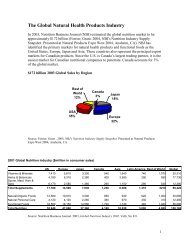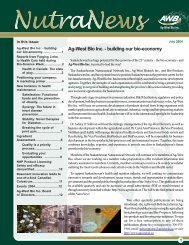Beyond Borders: Global biotechnology report 2010
Beyond Borders: Global biotechnology report 2010
Beyond Borders: Global biotechnology report 2010
You also want an ePaper? Increase the reach of your titles
YUMPU automatically turns print PDFs into web optimized ePapers that Google loves.
Perspectives on personalized medicine<br />
What one thing would you change to accelerate<br />
the adoption of personalized medicine?<br />
No one challenges the essential premise of personalized medicine —<br />
to deliver better therapies to patients. Made possible by the dramatic<br />
and continuing advances of 21st-century science and technology,<br />
personalized medicine can increase efficacy, decrease risk, open<br />
opportunities to prevent disease before it occurs, and lower systemic<br />
cost. Nevertheless, despite this great promise, as the chart below<br />
illustrates, we are nowhere near redefining the way medicine is<br />
practiced, even where the products that would allow us to do so are<br />
available. Indeed, there are many barriers and obstacles that deter<br />
investment in and slow the clinical adoption of personalized medicine.<br />
In partnership with Ernst & Young, we asked seven leaders from<br />
across the health care spectrum — from a venture capitalist to a<br />
patient advocate — to suggest one change they would make to<br />
State of personalized medicine adoption<br />
Insurance coverage<br />
and reimbursement<br />
Genetic privacy and<br />
legal protections<br />
Technology and tools<br />
Recognition of value<br />
Enactment of policy<br />
or legislation<br />
Pilots and<br />
precedent<br />
Full implementation<br />
and standardization<br />
96 <strong>Beyond</strong> borders <strong>Global</strong> <strong>biotechnology</strong> <strong>report</strong> <strong>2010</strong><br />
Edward Abrahams<br />
Personalized Medicine Coalition<br />
President<br />
accelerate the development and clinical adoption of personalized<br />
medicine.<br />
Taken together, their comments are revealing. They point toward a<br />
new definition for health care reform, focusing on aligning incentives<br />
in research, insurance coverage and reimbursement, and on<br />
regulation as the agents of change. If, as proponents of personalized<br />
medicine argue, the government’s signals to both public and private<br />
sectors were coordinated and targeted toward the goal of achieving<br />
higher-quality, more-efficient medicine at lower systemic costs, then<br />
patients and society could both be winners.<br />
As Health and Human Services Secretary Kathleen Sebelius has<br />
written, personalized medicine “presents the opportunity of<br />
transformational change.”<br />
Regulation<br />
Medical education<br />
Health care information<br />
technology<br />
Source: “The Case for Personalized Medicine,” Personalized Medicine Coalition, May 2009.<br />
The implementation of personalized medicine requires a confluence of several sectors (represented by wedges).<br />
The concentric circles represent stages of implementation for each sector, the final stage being full implementation and standardization.








